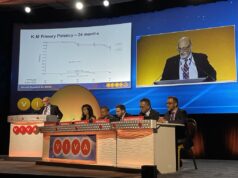
The IN.PACT SFA trial’s co-principal investigator John Laird, from the Adventist Heart and Vascular Institute in St. Helena, USA, has presented the five-year outcomes at the Vascular Interventional Advances annual conference (VIVA; 5–8 November, Las Vegas, USA). The results demonstrate the maintained durability, safety and efficacy of the IN.PACT Admiral drug-coated balloon (Medtronic; DCB) in patients with peripheral arterial disease.
Using time-to-event survival analysis, the IN.PACT Admiral DCB continued to outperform the percutaneous transluminal angioplasty (PTA) control arm in freedom from clinically-driven target lesion revascularisation (CD-TLR) over the five-year follow-up period. The Kaplan-Meier estimate was 74.5% in the DCB group versus 65.3% in the PTA group (p=0.0196).
Long-term safety benefits included low rates of major target limb amputation (0.5%) and thrombosis (2.2%) in the DCB arm, and no device or procedure-related deaths through five years across the DCB and PTA arms.
Speaking at VIVA, Laird stated, “This is the bottom line: at five years, there was sustained benefit with regards to freedom from clinically driven target lesion revascularisation (CD-TLR), with a freedom from CD-TLR rate at 74.5% with drug-coated balloon, versus 65.3% with standard balloon angioplasty: a delta benefit of 9.2%.”
Beneficial outcomes for this patient cohort have been reported over the five years, with patency last presented at three years, and the CD-TLR endpoint at four and five years. While these benefits are indeed sustained in the long term, Laird noted that “we clearly see a narrowing of that benefit over time”.
He added that patients in the two groups were “well-matched with regards to their baseline characteristics. These were primarily claudicants, with moderate to severe claudication, and only 5% of patients had ischaemic rest pain. 20–26% had total occlusions, and only a minority had severe calcification—this was by trial design.”
“We tried hard to avoid provisional stenting in this trial, and were mostly successful: it was a 7.3% provisional stent rate in the DCB arm of the trial, and 12.6% in the PTA arm of the trial—this likely reflected some operator bias.”
Commenting on the low rate of reintervention, Laird maintained that “this is truly remarkable considering the complexity and progressive nature of PAD. For these patients, it means we are providing them with a long-term, durable solution that reduces the need for frequent reinterventions, leading to a potential improvement in their quality of life.”
Laird concluded by reiterating the long-term safety and efficacy of the DCB indicated by this trial’s results. He added, “this is the first independent adjudicated blinded randomised trial to demonstrate superior effectiveness of a drug-coated balloon through five years. […] There were no device procedure- or paclitaxel-related deaths through five years, and also very little thrombosis rates through five years. This trial demonstrated there is durable effectiveness of this particular drug-coated balloon for the treatment of femoropopliteal occlusive disease, and supports the fact that DCB can be considered a first-line therapy for this treatment area.”












